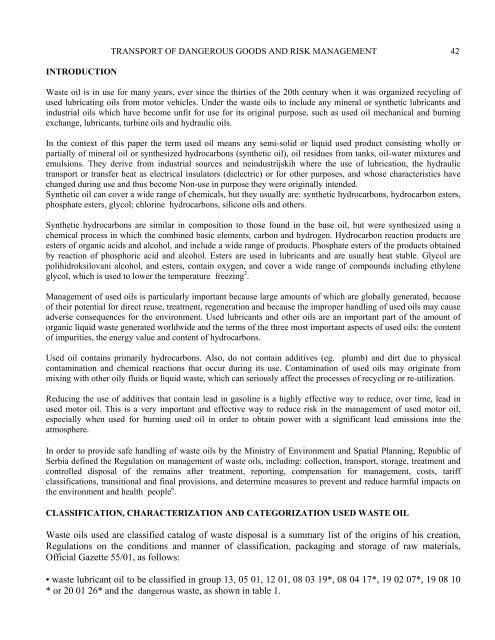transport of dangerous goods and risk management - Kirilo SaviÄ
transport of dangerous goods and risk management - Kirilo SaviÄ
transport of dangerous goods and risk management - Kirilo SaviÄ
Create successful ePaper yourself
Turn your PDF publications into a flip-book with our unique Google optimized e-Paper software.
INTRODUCTIONTRANSPORT OF DANGEROUS GOODS AND RISK MANAGEMENT 42Waste oil is in use for many years, ever since the thirties <strong>of</strong> the 20th century when it was organized recycling <strong>of</strong>used lubricating oils from motor vehicles. Under the waste oils to include any mineral or synthetic lubricants <strong>and</strong>industrial oils which have become unfit for use for its original purpose, such as used oil mechanical <strong>and</strong> burningexchange, lubricants, turbine oils <strong>and</strong> hydraulic oils.In the context <strong>of</strong> this paper the term used oil means any semi-solid or liquid used product consisting wholly orpartially <strong>of</strong> mineral oil or synthesized hydrocarbons (synthetic oil), oil residues from tanks, oil-water mixtures <strong>and</strong>emulsions. They derive from industrial sources <strong>and</strong> neindustrijskih where the use <strong>of</strong> lubrication, the hydraulic<strong>transport</strong> or transfer heat as electrical insulators (dielectric) or for other purposes, <strong>and</strong> whose characteristics havechanged during use <strong>and</strong> thus become Non-use in purpose they were originally intended.Synthetic oil can cover a wide range <strong>of</strong> chemicals, but they usually are: synthetic hydrocarbons, hydrocarbon esters,phosphate esters, glycol; chlorine hydrocarbons, silicone oils <strong>and</strong> others.Synthetic hydrocarbons are similar in composition to those found in the base oil, but were synthesized using achemical process in which the combined basic elements, carbon <strong>and</strong> hydrogen. Hydrocarbon reaction products areesters <strong>of</strong> organic acids <strong>and</strong> alcohol, <strong>and</strong> include a wide range <strong>of</strong> products. Phosphate esters <strong>of</strong> the products obtainedby reaction <strong>of</strong> phosphoric acid <strong>and</strong> alcohol. Esters are used in lubricants <strong>and</strong> are usually heat stable. Glycol arepolihidroksilovani alcohol, <strong>and</strong> esters, contain oxygen, <strong>and</strong> cover a wide range <strong>of</strong> compounds including ethyleneglycol, which is used to lower the temperature freezing 2 .Management <strong>of</strong> used oils is particularly important because large amounts <strong>of</strong> which are globally generated, because<strong>of</strong> their potential for direct reuse, treatment, regeneration <strong>and</strong> because the improper h<strong>and</strong>ling <strong>of</strong> used oils may causeadverse consequences for the environment. Used lubricants <strong>and</strong> other oils are an important part <strong>of</strong> the amount <strong>of</strong>organic liquid waste generated worldwide <strong>and</strong> the terms <strong>of</strong> the three most important aspects <strong>of</strong> used oils: the content<strong>of</strong> impurities, the energy value <strong>and</strong> content <strong>of</strong> hydrocarbons.Used oil contains primarily hydrocarbons. Also, do not contain additives (eg. plumb) <strong>and</strong> dirt due to physicalcontamination <strong>and</strong> chemical reactions that occur during its use. Contamination <strong>of</strong> used oils may originate frommixing with other oily fluids or liquid waste, which can seriously affect the processes <strong>of</strong> recycling or re-utilization.Reducing the use <strong>of</strong> additives that contain lead in gasoline is a highly effective way to reduce, over time, lead inused motor oil. This is a very important <strong>and</strong> effective way to reduce <strong>risk</strong> in the <strong>management</strong> <strong>of</strong> used motor oil,especially when used for burning used oil in order to obtain power with a significant lead emissions into theatmosphere.In order to provide safe h<strong>and</strong>ling <strong>of</strong> waste oils by the Ministry <strong>of</strong> Environment <strong>and</strong> Spatial Planning, Republic <strong>of</strong>Serbia defined the Regulation on <strong>management</strong> <strong>of</strong> waste oils, including: collection, <strong>transport</strong>, storage, treatment <strong>and</strong>controlled disposal <strong>of</strong> the remains after treatment, reporting, compensation for <strong>management</strong>, costs, tariffclassifications, transitional <strong>and</strong> final provisions, <strong>and</strong> determine measures to prevent <strong>and</strong> reduce harmful impacts onthe environment <strong>and</strong> health people 6 .CLASSIFICATION, CHARACTERIZATION AND CATEGORIZATION USED WASTE OILWaste oils used are classified catalog <strong>of</strong> waste disposal is a summary list <strong>of</strong> the origins <strong>of</strong> his creation,Regulations on the conditions <strong>and</strong> manner <strong>of</strong> classification, packaging <strong>and</strong> storage <strong>of</strong> raw materials,Official Gazette 55/01, as follows:• waste lubricant oil to be classified in group 13, 05 01, 12 01, 08 03 19*, 08 04 17*, 19 02 07*, 19 08 10* or 20 01 26* <strong>and</strong> the <strong>dangerous</strong> waste, as shown in table 1.








